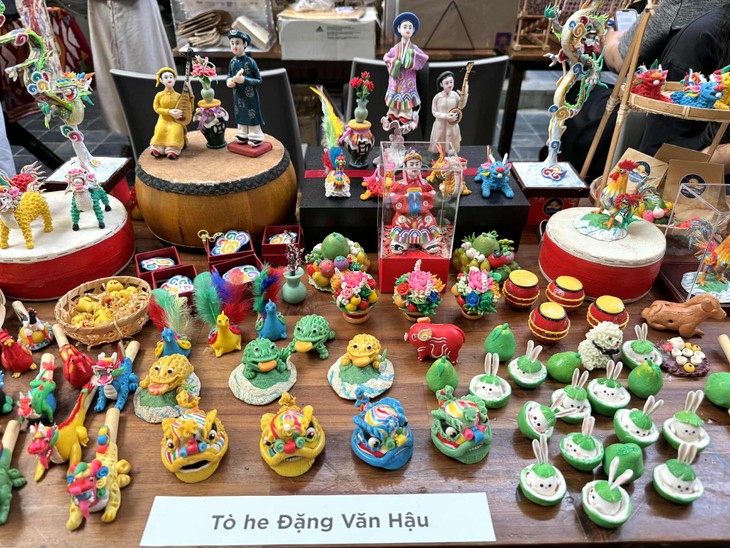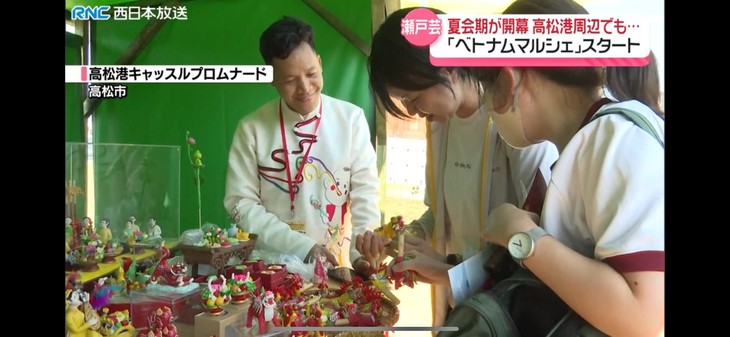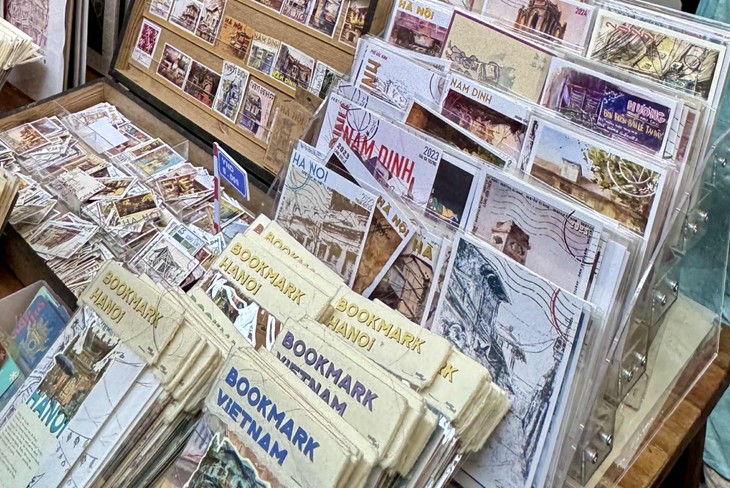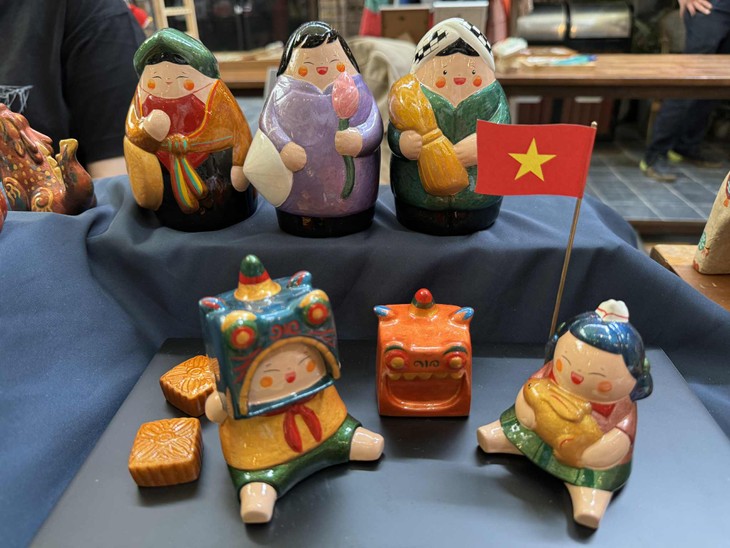Whether you're strolling through Hanoi’s Old Quarter or visiting historical and cultural landmarks in the city, you can easily come across handmade products inspired by folk traditions, yet highly functional, either for display or everyday use.

To he figurines by artisan Dang Van Hau (photo: Cam Thi)
Tò he figurines, once made of edible flour for children to play with and eat, have been reimagined by artisans using more durable materials, turning them into lasting souvenirs. Pillow covers, t-shirts, and handbags are now printed with images of ancient architecture; books come with lacquer or dó paper covers; and postcards depict charming street corners and architectural highlights of ancient towns. These handcrafted items are not only aesthetically pleasing but also reflect the cultural depth of Vietnam. To keep these values alive, Hanoi has introduced several policies to promote the development of cultural industries. We’ll explore these policies and meet young creatives who are retelling heritage stories in their own ways.

Handicraft products of Craft Link (photo: Cam Thi)
Bui Thi Huong Thuy, Deputy Head of the Heritage Management Department at the Hanoi Department of Culture and Sports, elaborated on heritage-focused cultural policy: “Hanoi has conducted a comprehensive inventory of tangible and intangible heritages across the city. It’s a detailed and open database covering all folk arts, crafts, and festivals. The city prioritizes the planning and preservation of heritage spaces, especially national special relics like the Temple of Literature and other major cultural centers. Hanoi is also the first locality with the most favorable support policies for artisans, offering an initial 1,900 USD for newly formed heritage clubs and 760 USD annually for operations. These policies apply to all artisans engaged in folk knowledge and arts.”
Ms. Thuy said that for years, the city and the heritage conservation community have advocated transforming heritage into cultural products, which are commercially viable and highly creative items that generate economic benefits while bearing Vietnam’s cultural identity.
There are two significant milestones. The Heritage Law which takes effect on July 1, 2025, introducing many detailed provisions to safeguard and promote tangible and intangible heritage. Another is the Capital Law, effective from this year, which specifies breakthrough policies for heritage, cultural products, and encourages social participation and private sector investment in culture and sports.
Ms. Thuy said: “The Capital Law encourages socialization and private enterprises to participate in cultural industry, sports, and tourism. It stipulates the establishment of a conservation and development fund for the Old Quarter, allowing for resources to be mobilized from domestic and foreign sources to restore, embellish, and promote the area. The Municipal People’s Council has also approved two resolutions to develop cultural industry and cultural commercial zones, prioritizing areas like the Red River alluvial grounds and heritage-rich spaces. With previous public investment and the new legal framework, Hanoi's full potential will be unlocked.”
These policies have created a favorable environment for young people to confidently start heritage-based businesses. Many have already transformed tradition into unique creative ventures. Examples include handcrafted products from Napo, Craftivity, Boi An, and the To he figurines of Xuân La village.

Artisan Dang Van Hau introduces To he figurines in Japan.
Artisan Dang Van Hau, who has spent 20 years making To he figurines and developing long-lasting dough, introduces his signature items.
“I always draw inspiration from Vietnamese folk culture, which has a wealth of historical figures and stories. For instance, last year I created a set of four beautiful female figurines for a company to bring to an exhibition in South Korea. One of my favorite collections is the Moon Fairy wearing the Vietnamese traditional attire. These figurines are characters in folk culture, like Cheo opera or Ca tru ceremonial singing, both recognized by UNESCO as intangible heritage. Our products can absolutely become cultural products that tell meaningful tales,” Hau said.
As Vietnam’s digital and tech sectors rapidly advance, new opportunities are emerging for culture and creativity. Artisans, heritage researchers, creative entrepreneurs, and designers are leveraging digital platforms for collaboration, innovation, and client engagement.
To he artisan Dang Van Hau said: “To he is already a piece of folk heritage, but what's exciting is that we’re using it to tell other cultural stories. We've built a Facebook page and will soon add QR codes to our products. When scanned, it links to an article, for example one about the ‘Five-Virtue Rooster’, a symbol of the ideal gentleman in Vietnamese culture. This is how we use technology to enrich traditional storytelling.”

Drawings of old streets, temples, an churches by Nhip Pho (photo: Cam Thi)
Besides well-established artisans and craft enterprises, many students passionate about culture and heritage have started micro-businesses, each with a unique perspective to share. Pham Minh Tuan, a representative of Nhip Pho, a brand run by three young students devoted to sketching ancient houses, old streets, and heritage towns, says they want to bring these images into art and everyday items. Each postcard and stamp is a watercolor sketch capturing the charm of old urban architecture.
“With a love for the old streets, temples, and churches in cities like Hanoi and Nam Định (now Ninh Binh province), we’ve painted watercolors and iron-pen drawings of these scenes. We want to share this passion by drawing them on posters, stamps, and using traditional materials like dó paper. Though our business is still small, we’re pursuing our dream of spreading images of familiar old towns to overseas Vietnamese and international tourists visiting Vietnam,” Tuan said.
Most small handcraft brands like Nhip Pho don’t have physical stores yet, they primarily use social media to reach customers. In Hanoi’s creative cultural spaces like Complex-1 on Tây Sơn Street or Ho Van at the Temple of Literature, events are frequently held to introduce handcraft brands and connect with the community. These events are opportunities for small brands to directly present their products to the public.

Products by Boi An (photo: Cam Thi)
Mr. Le Xuan Kieu, Director of the Center for Cultural and Scientific Activities at the Temple of Literature, said that in recent years, the site has undergone a strong transformation, becoming a friendly cultural space that honors tradition while embracing modernity. The center has partnered with designers, entrepreneurs, and craft villages to produce items featuring patterns and motifs related to the Temple of Literature, such as the stone steles – iconic elements of Hanoi's cultural heritage, to sell to tourists.
“We think souvenirs at the Temple of Literature encompass several criteria. They must reflect intangible values, carry traditional motifs and stories about the Temple and its historical figures, be produced by Hanoi’s craft villages, eco-friendly, and useful for everyday life, such as pens, notebooks, shirts, hats, scarves, and fans. Most importantly, they must be compact and easy for visitors to carry home.”
Hanoi’s membership in UNESCO’s Creative Cities Network is an international recognition of its creative capacity. With existing resources, artisans, heritage, and a new generation passionate about cultural products, Vietnamese culture is being retold through each creation. These stories promote Vietnam’s image as well as breathe new life into its cultural identity.
Cam Thi